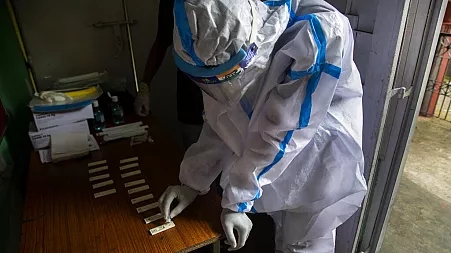A new coronavirus variant has risen to dominance in the U.S. as COVID cases continue to increase amid a summer wave of infections. But what are the symptoms of this new variant, and how do they compare to previous strains?
As of August 3, the now-dominant coronavirus subvariant, KP.3.1.1, accounts for more than 1 in 4 U.S. COVID-19 cases, according to the U.S. Centers for Disease Control and Prevention (CDC). Experts have said that it may be more of a challenge to our immune systems compared to previous variants.
KP.3.1.1 is one of a class of several new variants, nicknamed FLiRT due to the positions of the mutations in the projections on their surface that allow them to enter into our cells. These projections, known as spike proteins, are also used as targets by our immune systems and vaccinations, so changes in their structure can allow the virus to bypass our body's defenses more easily.
Early analysis (that has not been peer-reviewed) suggests that KP.3.1.1 may be significantly more infectious than previous variants, including other FLiRT variants. It may also be better at evading our immune systems and immunity conveyed by existing vaccines.
In line with the rise of these new variants, COVID cases across the U.S. have seen a significant uptick in recent weeks, with 16.3 percent of tests coming back positive for the week ending July 27, according to the CDC. This has been matched by a surge in COVID-19 detection in wastewater across the U.S., with very high levels detected in 20 states.
But does this mean the new variants are any more dangerous?
From what we have seen so far, the new FLiRT variants do not generally cause severe symptoms. Hospitalizations still remain relatively low, as are death rates. According to Johns Hopkins Bloomberg School of Public Health, symptoms are the same as previous versions of the virus, usually with milder expression.
As listed by the CDC, the symptoms include the following:
- Fever or chills
- Cough
- Shortness of breath
- Fatigue
- Muscle or body aches
- Headache
- Loss of taste or smell
- Sore throat
- Runny nose
- Nausea or vomiting
- Diarrhea
However, more vulnerable individuals may still be at risk of severe illness, so it is important to self-isolate if you receive a positive COVID test.
Is there a health problem that's worrying you? Let us know via health@newsweek.com. We can ask experts for advice, and your story could be featured in Newsweek.
References
Kaku, Y., Uriu, K., Okumura, K., Ito, J., & Sato, K. (2024). Virological characteristics of the SARS-CoV-2 KP.3.1.1 variant. bioRxiv (Cold Spring Harbor Laboratory). https://doi.org/10.1101/2024.07.16.603835
Disclaimer: The copyright of this article belongs to the original author. Reposting this article is solely for the purpose of information dissemination and does not constitute any investment advice. If there is any infringement, please contact us immediately. We will make corrections or deletions as necessary. Thank you.




